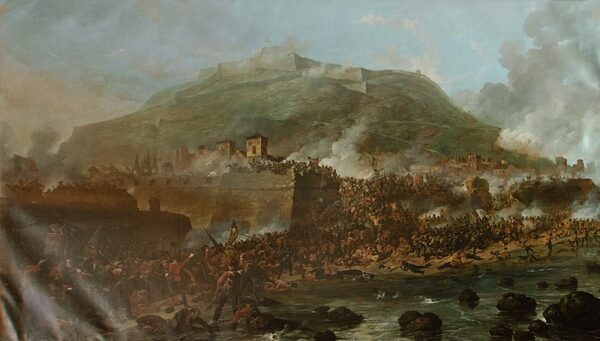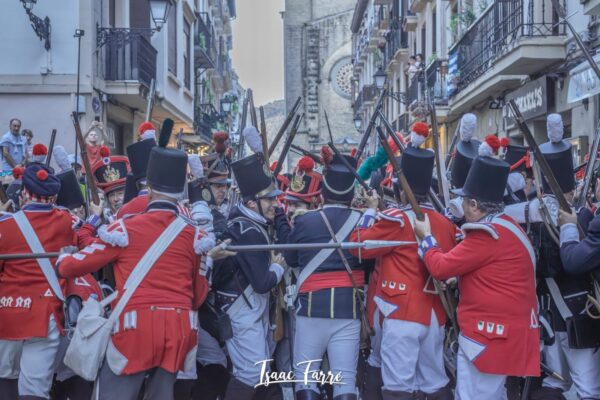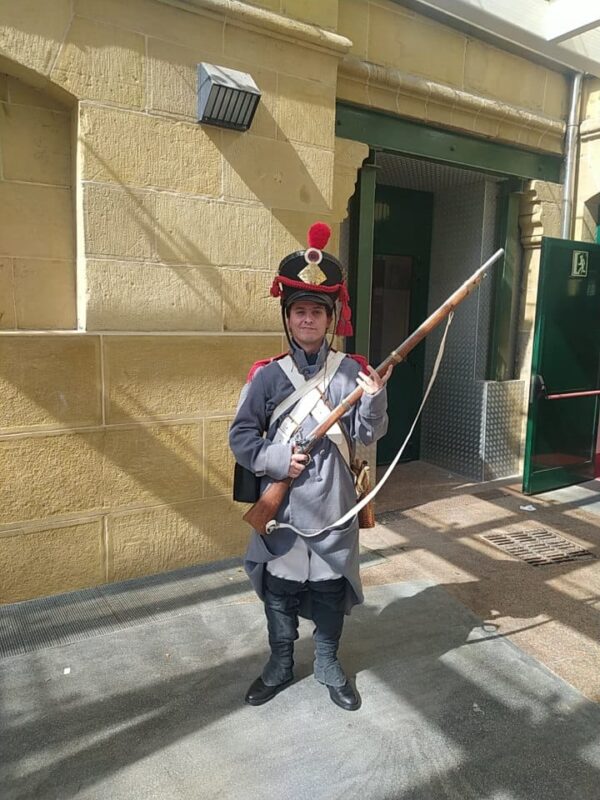31st of August Donostia 2024

If there is one important date in the history of San Sebastian that marks a before and after and brings a profound transformation to the city, it is the 31st of August 1813.
The day Donostia was destroyed
In 1808, in the midst of the Napoleonic Wars, San Sebastian was invaded by the French army, which stayed in the city for five years, until 1813.
In the summer of 1813, after passing through Vitoria, an army of English and Portuguese troops arrived in San Sebastian with the intention of liberating the city from French occupation. They besieged the city for weeks during which they tried to take it without much success, through various breaches that they created in the city walls, but which were strongly defended by the French.

The Storming of San Sebastian by Denis Dighton. Date unknown.
Thus, on the morning of the 31st of August, the English and Portuguese managed to destroy the last defences and finally enter San Sebastian. And although they were greeted with applause and cheers by the locals, the supposed saviours responded with gunfire. Enraged by the numerous casualties and the frustration of weeks of trying to take the city, the Anglo-Portuguese soldiers entered Donosti and razed everything to the ground.
Drunk on alcohol stolen from houses and shops, they ransacked the entire city and set fire to it. The French, retreating to the castle on top of Urgull, simply wait for the chaos to end before surrendering on 8 September.
The attack lasts for a week during which many men and women are killed, the latter after being raped. It is estimated that about half the population is killed that week, about 4,000 people. The entire city is destroyed by fire, only 36 houses are spared. The archives and the town hall are burnt, losing an infinite amount of information about San Sebastian. The basilica of Santa Maria is emptied of its riches, as are the neighbours, who see their property and belongings disappear. This was undoubtedly the worst moment in the history of San Sebastian.

English and French fighting in the Old Town. Photo by Isaac Farré.
Programme
Today the 31st of August is a special date in the calendar of San Sebastian, when we remember the almost total destruction of our city, but in a way, when we celebrate the reconstruction of it.
The day’s programme includes a mass in Santa María at 11:30 and an offering of flowers in Portaletas at 12:45.
And in the afternoon at 17:30 various military parades start around the city, representing the armies that took part in the siege of 1813. The English and Portuguese approach from Gros, while the French parade through the Old Town. After the minute’s silence at 19:00 at the Boulevard kiosk, at 19:30 the re-enactment of the assault on the Bretxa and the capture of the city begins, and culminating at 21:00 with the re-enactment of the capture of the castle and the burning of Donosti in Zuloaga Square.

Our Hegoi, ready for battle.
Commemorative event
After the “fun” part of the programme, at 21:30 the main commemorative event of the day begins. In the 31st of August Street (so called because it is the only street that survived the fire) all the lights are switched off and candles are lit. San Sebastian flags with black bunting are hung from balconies and church bells ring out all over the city.
Thus, lit by torches, a ceremonial walk takes place from the atrium of San Vicente, where the old hymn of Donosti is sung, to the atrium of Santa María, where the current hymn is sung, with stops in the alley of Valle de Lersundi and the Plaza de la Trinidad. All accompanied by several local choirs and the municipal band of txistularis.
This last act is perhaps the most moving moment of the day, as the victims of 1813 are remembered and tribute is paid to the survivors who rebuilt the city, our ancestors thanks to whom we are who we are today. The culminating moment comes when the San Sebastian March is sung in front of the Basilica of Santa Maria, as this is the only time of the year, apart from the day of San Sebastian, when we can sing it.